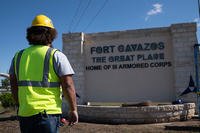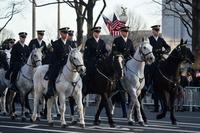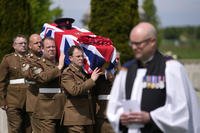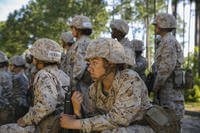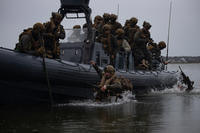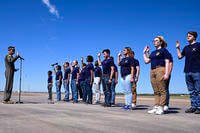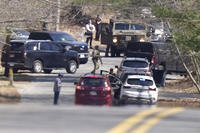As the 26th Marine Expeditionary Unit gets ready to deploy, it is heading to foreign shores without a key piece of equipment that other MEUs have typically had: combat landing vehicles.
The commander of the 26th MEU recently told reporters that his unit has had to improvise as the Corps currently has a restriction on using its new Amphibious Combat Vehicle (ACV) in the surf zones offshore following a string of rollover incidents in Southern California.
While aboard the amphibious assault ship USS Bataan, Col. Dennis Sampson, the MEU's commander, told a group of reporters last week that his unit has found ways to improvise and in some areas enhance its abilities while deployed, but that it will miss its landing vehicles.
Read Next: Pentagon Sends 1,500 Active-Duty Troops to Border as Pandemic Immigration Restrictions End
"We're heavily reliant on our aviation assets to build combat power ashore," Sampson said, describing how his unit is compensating for the lack of the ACV, adding that the unit is now "more reliant” on landing craft that the Navy provides and operates.
Until a few years ago, a unit like the 26th MEU would set off on several Navy ships with a complement of Amphibious Assault Vehicles (AAVs) -- a nearly 30-ton armored box with tracks -- that Marines could use to land ashore. However, the craft, which had been in service since the 1970s, were pulled from service after an AAV sank during an exercise in 2020, killing eight Marines and a Navy corpsman.
The AAV's replacement, the similarly boxy but wheeled ACV, was rushed into service, but the vehicles were pulled out of the water entirely while crews conducted safety training last fall after the rollovers.
Now, the ACV can operate everywhere but the surf, and the Corps is launching a new training program to make operations safer. For now, Marines who are deployed at sea are left to find alternatives.
"We'd like to have ACVs for sure," Sampson told reporters who had been invited to observe two days of operations with the Navy and Marine Corps.
Given this landscape, Sampson said his unit has pivoted to training Marines from the amphibious assault battalions that normally operate craft like the ACV and teach them to operate the Navy's 11-meter-long small boats.
"We put them through the Navy coxswain's courses, and they are able to drive and operate the ships to a high standard," he explained.
"That's really our effort to fill … a gap based off not having amtracs or AAVs, ACVs," Sampson said.
The result, according to the commander, is more flexibility for operations in coastal water, allowing the Marines to run missions like ship boardings and inspections. The arrangement also offers sailors help in sharing the burden of operating and maintaining the boats.
"If there's a mission that we require them, we can operate them," Sampson said before adding that if one of the ships in the group has a mission, "we can operate them in support of their efforts."
However, the boats carry fewer people than the ACVs, they are far less protected, and they cannot take Marines from the ship all the way to land and back. They cannot replace ACVs in amphibious operations -- a mission that the service's top officer, Commandant Gen. David Berger, has called "a foundational aspect of the Marine Corps."
-- Konstantin Toropin can be reached at konstantin.toropin@military.com. Follow him on Twitter @ktoropin.
Related: Marines Look to Get Closer to Special Operations Teams While Practicing Extractions


